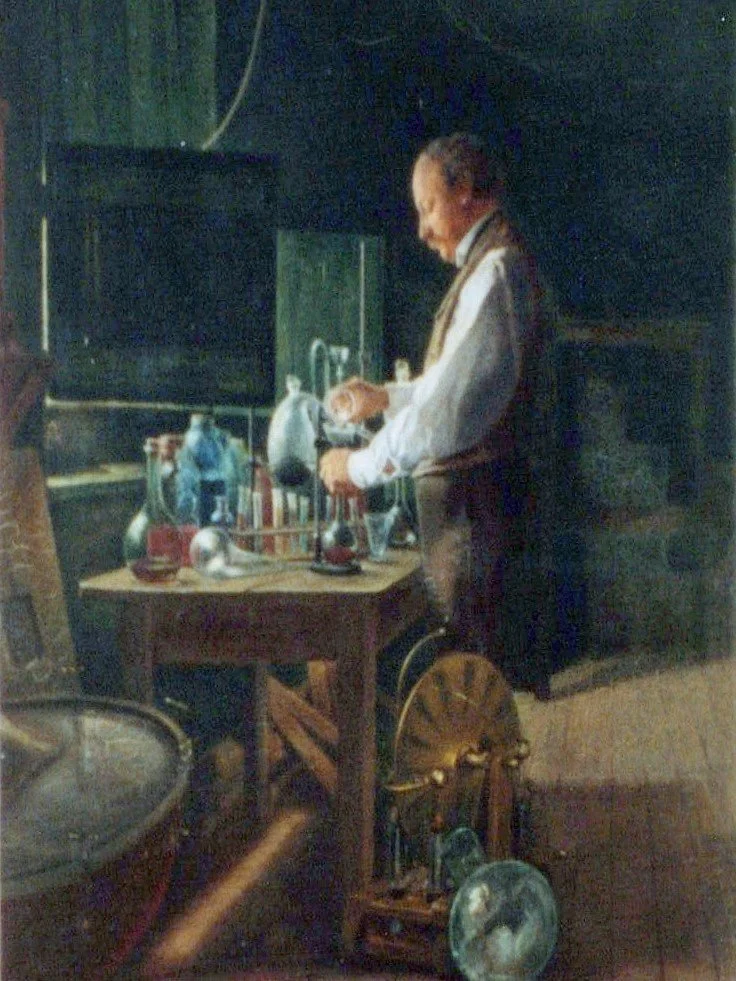
Favorite Scientists
Lord Rayleigh in his laboratory in Terling Place
Lord Rayleigh the Third
Discoverer of Argon and Many Acoustic and Electromagnetic Principles
Lord Rayleigh, John Williams Strut, the third, (1842-1914) was a pioneering gentleman scientist whose innovations in acoustics, chemistry, optics, thermodynamics, general mechanics, hydrodynamics, electricity and magnetism, spectroscopy, perception, and electromagnetic waves changed the world. Lord Rayleigh's many discoveries and inventions were given freely to benefit the general public. His legacy continues to improve our lives today. As an example, he devised an ingenious apparatus in the basement of his manor house to discover the element argon for which he won a Nobel Prize. He derived equations for the motion of surface acoustic waves on the top of waves propagating on the surface of solids. These Rayleigh waves, propagating on piezoelectric crystals, led to surface wave filters, billions of which are made each year, and several of which may be in your cell phone.
Lord Rayleigh’s laboratory in Terling Place in 1995
I was fortunate enough to visit his laboratories in his house in Terling Place, United Kingdom. In 1995, our small group saw ancient bottles of chemicals, blobs of mercury, original instruments and burnt marks on wood where pipettes were bent into desired shapes with a torch. His laboratories looked as if he just walked out the door and was expecting to return any minute to devise his next experiment.
T.L.S.
Lord Rayleigh. Scientific Papers, 1899 -1919, Dover Publications, Inc., 1964 (six volumes, bound as three).
John William Strutt, Baron Rayleigh, The Theory of Sound, Volumes 1 and 2, second edition, Dover Publications, Inc., 1945 (two volumes).
Langevin portrait : Paul Langevin (1872-1946)
Paul Langevin: The Originator of Ultrasonics
William Cady claimed in 1946, that Langevin was ‘the originator of the modern science and art of ultrasonics’. If he were alive today, he would be amazed at the number of modern industries and applications which have been derived from his quartz piezoelectric ultrasound transducer.
When war broke out in 1914, he was a rising star of European physics, recognised for his theoretical work on gaseous ion mobility, diamagnetism, relativity and electron physics. At the urging of Marie Curie and Jean Perrin, Langevin directed his research towards finding enemy submarines underwater with ultrasound. After two years of initial work using a singing capacitor, he realised that a better practical solution was to use the piezoelectricity of natural quartz crystals, discovered by the Curie brothers and with which he was familiar. Specifically, he selected a crystal orientation which aligned the electrical with the stress axes. In his patented ‘sandwich transducer’ (1918) he increased overall gain by replacing the half-wavelength slice of X-cut quartz with a design that separated the electromechanical from the resonant properties, the latter being set by two quarter-wave steel plates, Lowering the resonance frequency to about 40 kHz and increasing the diameter to be greater than ten wavelengths satisfied the objective of a directive beam (rather than other omnidirectional acoustic systems) He used high powered transmitters and stages of triode amplifiers to increase detection sensitivity. Langevin succeeded in generating a kilowatt of acoustic power which resulted in killing fish, one of the first observations of ultrasound-induced bioeffects.
After the First World War, Langevin, maintained his interest in ultrasound until his anti-fascist activism limited his scientific work. In 1923, he presented an extensive course on ultrasonics at the Collége de France. He explored beam formation, including apodisation and dimensional asymmetry. Langevin’s work led directly to Wood and Loomis’ contributions on bioeffects, Boyle’s on cavitation, Florisson’s on commercial echo-sounding, Cady’s on frequency control. His team, including Japanese physicist Ishimoto, established the foundation for ultrasonic metrology, using piezoelectric probe hydrophones and radiation force. His work created the impetus for magneto-strictive transducers and other piezoelectric materials for underwater applications. Nevertheless, quartz remained the transducer material of choice in ultrasound laboratories.
Much of what we take for granted in ultrasound, the use of piezoelectric materials in transducers in half wave resonances, directive beams and pulse echo ranging and detection of distant or hidden objects, the characterization of transducer fields, started with Langevin’s ingenuity. The ubiquitous applications of the pulse echo principle to SONAR which was very successful at submarine detection in the second world war, to sound ranging, to diagnostic ultrasound, and to nondestructive ultrasound testing of metals and structures sprung from his original pioneering work. From F . A. Duck and T.L. Szabo, Paul Langevin: Originator of Ultrasonics , 2022 IEEE Ultrasonics Symposium, October 13, 2022.
Francis Duck , Paul Langevin, U-boats, and ultrasonics, Physics Today 75 (11), 42–48 (2022); https://doi.org/10.1063/PT.3.5122
F. A. Duck and, A. M. K. Thomas, Paul Langevin (1872-1946): the Father of Ultrasonics, Medical Physics International Journal, Special Issue, History of Medical Physics 10 (1),84-91, June 2024.
A. Langevin 2022. Paul Langevin, my father. The man and his work. (F. Duck, English edition). Paris, EDP Sciences. ISBN (print) 978-2-7598-2782-4 ISBN (ebook) 978-2-7598-2783-1
Bernadette Bensaude-Vincent, Francis Duck, Paul Langevin: Physicist and Social Activist, to be published in 2025, https://link.springer.com/book/9783031952593
F. A. Duck, Langevin’s ultrasonic metrology. IEEE Trans UFFC. 2023;70(2):173-180. (doi: 10.1109/TUFFC.2022.3222085)
Fonds Paul Langevin archive https://bibnum.explore.psl.eu/s/psl/item-set/24913
First publicity for the SCAM Langevin-Chilowsky ultrasonic depth sounder. Cover of La Nature, 21 July 1923.
The sink from Langevin’s physics laboratory in ESPCI Paris where, in the summer of 1915, he and Chilowsky carried out the first demonstration of the emission of ultrasound at 100 kHz from a singing condenser transducer, and measured its acoustic power using a torsion balance.
Plaque: IEEE Memorial plaque at ESPCI Paris - 10 rue Vauquelin -75005 Paris, France




